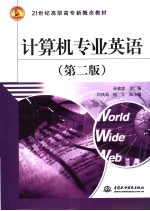

计算机专业英语PDF电子书下载
- 电子书积分:10 积分如何计算积分?
- 作 者:孙建忠主编
- 出 版 社:北京:中国水利水电出版社
- 出版年份:2007
- ISBN:7508441486
- 页数:206 页
学习指导 1
1.1 The Invention of the Computer 1
1.1.1 The ENIAC 1
Chapter 1 The History and Future of Computers 1
1.1.2 The UNIVAC I 2
1.2 Computer Generations 2
1.2.1 First-Generation Computers:1951~1958 3
1.2.2 Second-Generation Computers:1959~1963 3
1.2.4 Fourth-Generation Computers:1971~? 4
1.2.3 Third-Generation Computers:1964~1970 4
1.2.5 Generationless Computers 5
Reading Material:Near-future Supercomputer Directions 6
科技英语的特点 7
Exercises 10
Chapter 2 Basic Organization of Computers 11
学习指导 11
2.1 Introduction 11
2.2 System Buses 12
2.3 Instruction Cycle 13
2.4 CPU Organization 15
Reading Material:On 64-Bit Processing 17
计算机英语专业词汇的构成 18
Exercises 22
Chapter 3 Binary System and Boolean Algebra 23
学习指导 23
3.1 The Decimal System 23
3.3 Boolean Algebra 25
3.2 The Binary System 25
数学公式的读法(Pronunciation of mathematical expressions) 27
Exercises 30
Chapter 4 Elementary Data Structures 31
学习指导 31
4.1 Stacks and queues 31
4.1.1 Stacks 31
4.1.2 Queues 32
4.2 Linked lists 34
4.2.2 Inserting into a linked list 35
4.2.3 Deleting from a linked list 35
4.2.1 Searching a linked list 35
4.2.4 Sentinels 36
Reading Materials:Python 37
常用英汉互译技巧 38
Exercises 43
Chapter 5 Operating System 44
学习指导 44
5.1 OS Functions 44
5.1.1 Resource allocation and related functions 44
5.1.2 User interface related funetions 46
5.2 FreeBSD vs. Linux vs. Windows 2000 47
Reading Material:RATs 50
被动语态的译法 52
Exercises 55
Chapter 6 Software Engineering 56
学习指导 56
6.1 Basic Software Concepts 56
6.1.1 Application Software 57
6.1.2 System Software 57
6.2 The Software Life Cycle 58
6.2.1 System engineering and analysis 59
6.2.2 Software requirements analysis 59
6.2.3 Design 59
6.2.4 Coding 59
6.2.5 Testing 59
6.2.6 Maintenance 60
6.3 Prototyping 61
Reading Material:VoWLAN 62
复杂定语(从句)的翻译技巧之一 63
Exercises 66
Chapter 7 Programming Language 67
本章学习指导 67
7.1 Introduction to Programming Language 67
7.2 Object-oriented Programming 69
7.3 OMG's Unified Modeling Language(UML) 70
Reading Materials:Aspect-Oriented Programming 72
复杂定语(从句)的翻译技巧之二 74
Exercises 76
学习指导 78
8.1 The Internet:Key Technology Concepts 78
Chapter 8 The Internet 78
8.2 Other Internet Protocols and Utility Programs 84
8.3 Internet Service Providers 85
Reading Material:Who Governs The Internet 87
英语长句的翻译 88
Exercises 92
Chapter 9 The World Wide Web 93
学习指导 93
9.1 Hypertext 93
9.2 Markup Languages 94
9.3 Web Servers and Clients 96
9.4 Web Browsers 97
Reading Material:Features of The Internet and The Web 98
学术论文的英文写作简介 103
EXERCISE 105
Chapter 10 Network Security 106
学习指导 106
10.1 Secure Networks and Policies 106
10.4 Integrity Mechanism 107
10.3 Responsibility and Control 107
10.2 Aspects of Security 107
10.5 Access Control and Passwords 108
10.6 Encryption and Privacy 108
10.7 Public Encryption 109
10.8 Authentication with Digital Signatures 110
10.9 Packet Filtering 111
10.10 Internet Firewall Concept 112
Reading Material:Kinds of Security Breaches 113
学术论文标题的写法 114
Exercises 116
Chapter 11 Database Management 117
学习指导 117
11.1 Overview 117
11.2 Database Models 119
11.2.1 Flat File 119
11.2.2 Relational 119
11.2.3 Hierarchical 120
11.2.4 Other Database Models 121
11.3.2 Add-on packs 122
11.3.1 Oracle Entetprise Manager 122
11.3 Database Management Features of Oracle 122
11.3.3 Backup and Recovery 123
英文论文引言的写作技巧 124
Exercises 130
Chapter 12 Multimedia and Comptter Animations 131
学习指导 131
12.1 Multimedia 131
12.1.1 Visual Elements 132
12.1.2 Sound Elements 132
12.1.4 Multimedia Applications 133
12.1.3 Organizational Elements 133
12.2 Computer Animation 134
12.2.1 Design of Animation Sequences 134
12.2.2 General Computer-Animation Functions 135
英文摘要的写作技巧 136
Exercises 140
Chapter 13 Virtual Reality 142
学习指导 142
13.1 Virtual Reality 142
13.2 Real Work in Virtual Reality 144
13.3 About VRML 145
13.3.1 Design Criteria 145
13.3.2 Characteristics ot VRML 146
13.3.3 Scope 146
13.3.4 Each VRML file 146
求职英语简介 148
Exercises 151
14.2 The difference between e-commerce and e-business 152
14.1 What is e-commerce 152
学习指导 152
Chapter 14 The Basics of E-Commerce 152
14.3 Why study e-commerce 153
14.4 Fypes of e-commerce 154
14.5 Origins and growth of e-commerce 155
14.6 Technology and e-commerce in perspective 156
广告文体简介 158
Exercise 160
参考译文 162
主要参考文献及网站 206
- 《计算机网络与通信基础》谢雨飞,田启川编著 2019
- 《大学计算机实验指导及习题解答》曹成志,宋长龙 2019
- 《中央财政支持提升专业服务产业发展能力项目水利工程专业课程建设成果 设施农业工程技术》赵英编 2018
- 《“十三五”规划教材 中药鉴定学实验 供中药学 药学及相关专业使用 第2版》吴啟南 2018
- 《广西近代专业音乐研究》李昂责任编辑;(中国)杨柳成 2019
- 《计算机辅助平面设计》吴轶博主编 2019
- 《计算机组成原理解题参考 第7版》张基温 2017
- 《云计算节能与资源调度》彭俊杰主编 2019
- 《国家执业药师考试历年真题试卷全解 2015-2019 中药学专业知识 1》黄坤主编 2020
- 《全国学前教育专业(新课程标准)“十三五”规划教材 简谱手风琴教程 第2版》(中国)杨克勤,王宝庆 2019
- 《中国当代乡土小说文库 本乡本土》(中国)刘玉堂 2019
- 《异质性条件下技术创新最优市场结构研究 以中国高技术产业为例》千慧雄 2019
- 《中国铁路人 第三届现实主义网络文学征文大赛一等奖》恒传录著 2019
- 《莼江曲谱 2 中国昆曲博物馆藏稀见昆剧手抄曲谱汇编之一》郭腊梅主编;孙伊婷副主编;孙文明,孙伊婷编委;中国昆曲博物馆编 2018
- 《中国制造业绿色供应链发展研究报告》中国电子信息产业发展研究院 2019
- 《中央财政支持提升专业服务产业发展能力项目水利工程专业课程建设成果 设施农业工程技术》赵英编 2018
- 《中国陈设艺术史》赵囡囡著 2019
- 《指向核心素养 北京十一学校名师教学设计 英语 七年级 上 配人教版》周志英总主编 2019
- 《《走近科学》精选丛书 中国UFO悬案调查》郭之文 2019
- 《清至民国中国西北戏剧经典唱段汇辑 第8卷》孔令纪 2018
